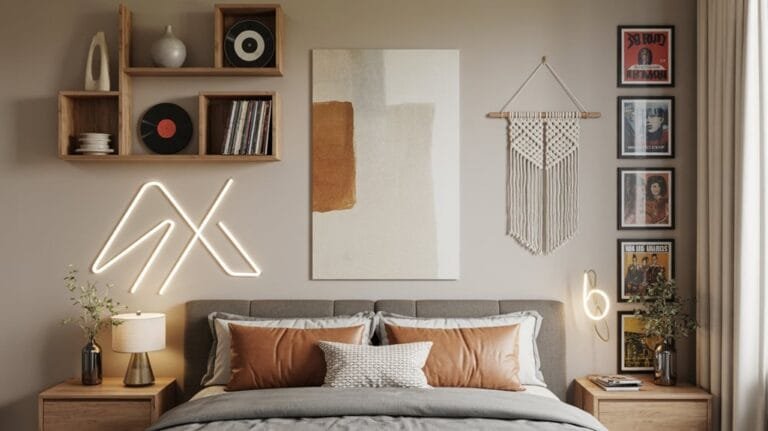11 Must-Know Layout Secrets for Your Compact Kitchen
As an amazon associate I earn from qualifying purchases.
You’re working with limited square footage, and every inch counts. A mini kitchen doesn’t mean you’ll sacrifice functionality or style—it means you’ll get strategic. By combining vertical storage, compact appliances, and smart layout choices, you’ll transform your cramped cooking space into something surprisingly efficient. But there’s a technique that separates mediocre small kitchens from exceptional ones.
Maximize Vertical Storage Space
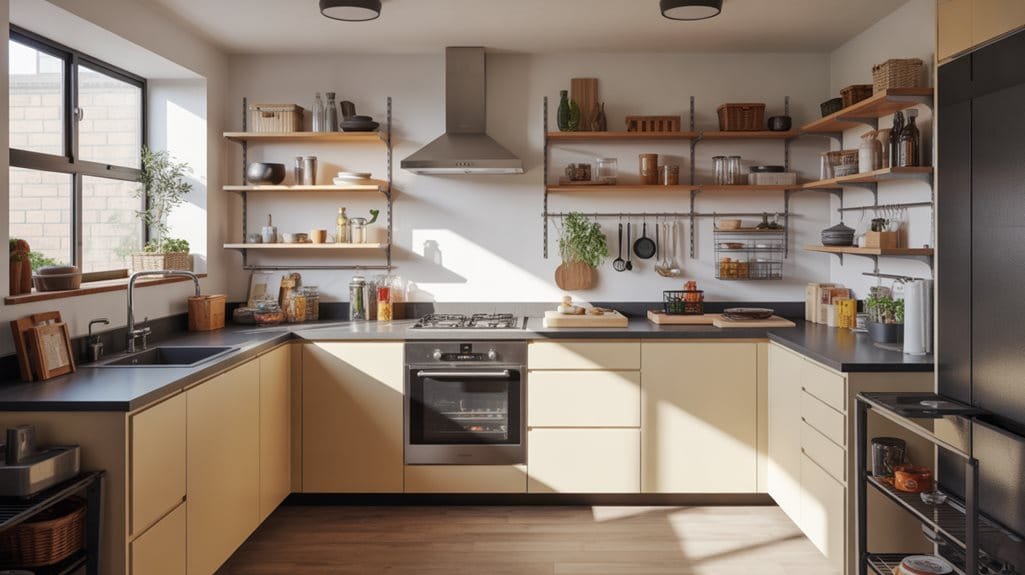
When you’re working with a compact kitchen, you can’t afford to waste wall space.
Install tall cabinets that reach your ceiling, maximizing every inch vertically.
Maximize vertical space in compact kitchens by installing tall cabinets that reach your ceiling, utilizing every available inch efficiently.
Mount wall-mounted racks for frequently used items, keeping countertops clear and accessible.
You’ll create an organized, efficient kitchen that works as hard as you do—transforming tight quarters into a functional, stylish space you’ll love using daily.
Choose Compact Appliances
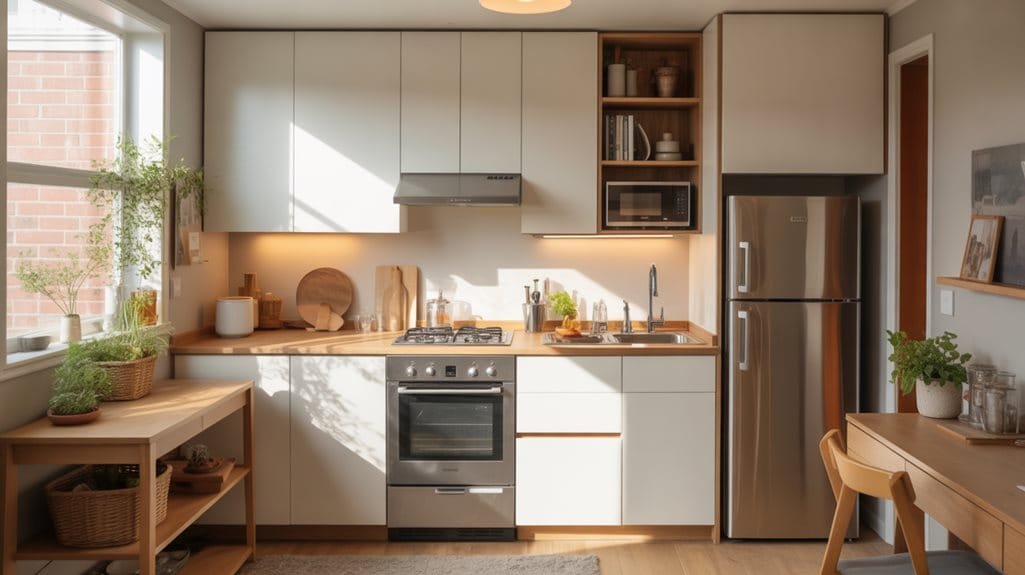
Since standard-sized appliances can quickly consume your mini kitchen’s precious real estate, you’ll want to prioritize compact models that don’t compromise functionality.
Look for energy-efficient units designed for small spaces. Guarantee appliance compatibility with your layout and existing fixtures.
Slimline refrigerators, compact dishwashers, and combination microwave-convection ovens maximize usability while respecting your kitchen’s footprint.
You’re creating an efficient, cohesive cooking space that truly works for you.
Optimize Your Layout
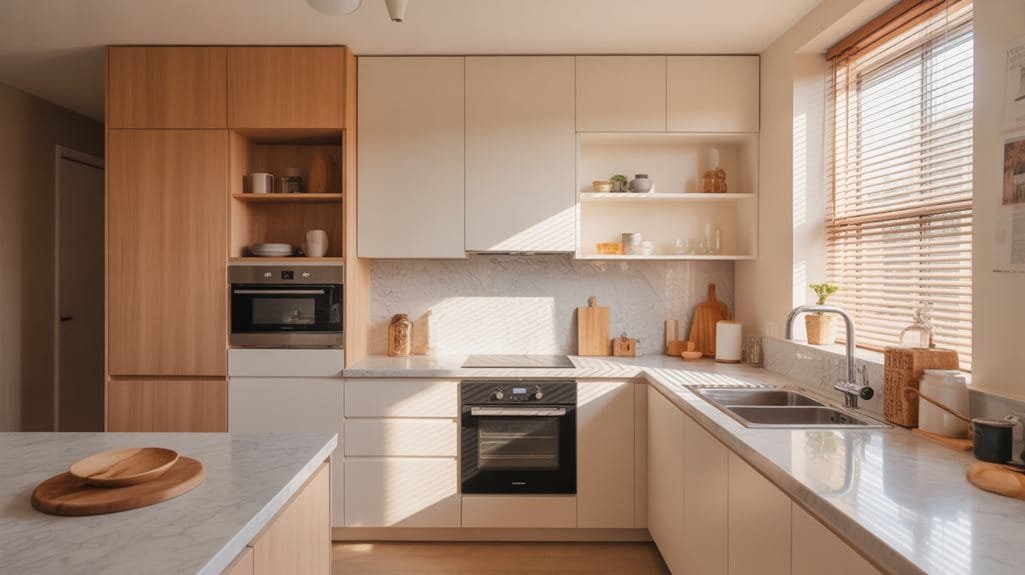
To maximize functionality in a compact kitchen, you’ll want to strategically arrange your workspace around the classic work triangle—the relationship between your sink, stove, and refrigerator.
This layout efficiency directly impacts your workflow optimization. Position frequently used items within arm’s reach, minimize wasted steps, and create zones for prep, cooking, and cleanup.
You’re designing a space that works as hard as you do.
Use Light Colors and Reflective Surfaces
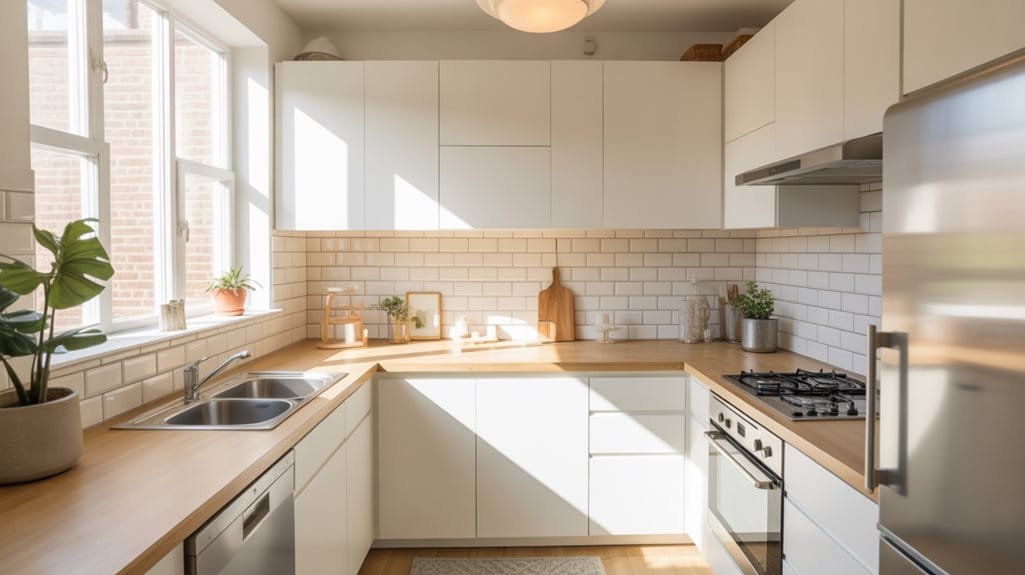
While optimizing your layout creates an efficient workflow, the visual atmosphere you cultivate determines whether your compact kitchen feels cramped or expansive.
You’ll leverage color psychology by choosing whites, creams, and soft pastels that visually enlarge your space.
Incorporate reflective materials—glossy backsplashes, polished hardware, and mirrored accents—to bounce light throughout, creating an airy, welcoming environment you’ll genuinely enjoy cooking in.
Install Open Shelving
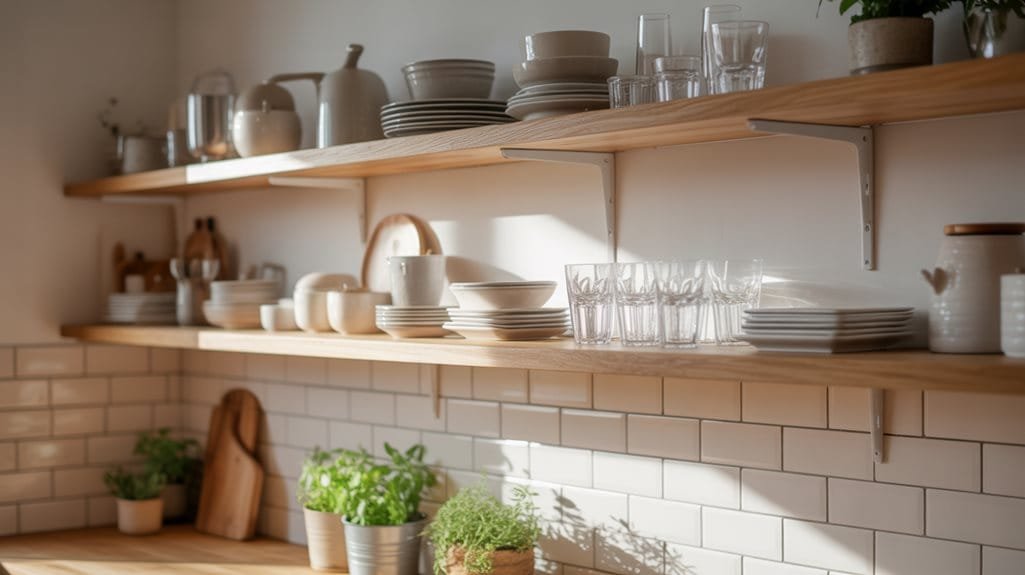
Open shelving transforms your mini kitchen by eliminating visual barriers that closed cabinets create, making the space feel immediately larger and more breathable.
Strategic shelf styling showcases your essentials while maintaining organization.
Smart material selection—glass, wood, or metal—complements your design vision.
You’ll curate a kitchen that reflects your style and invites connection with those you cook for.
Implement Multifunctional Furniture
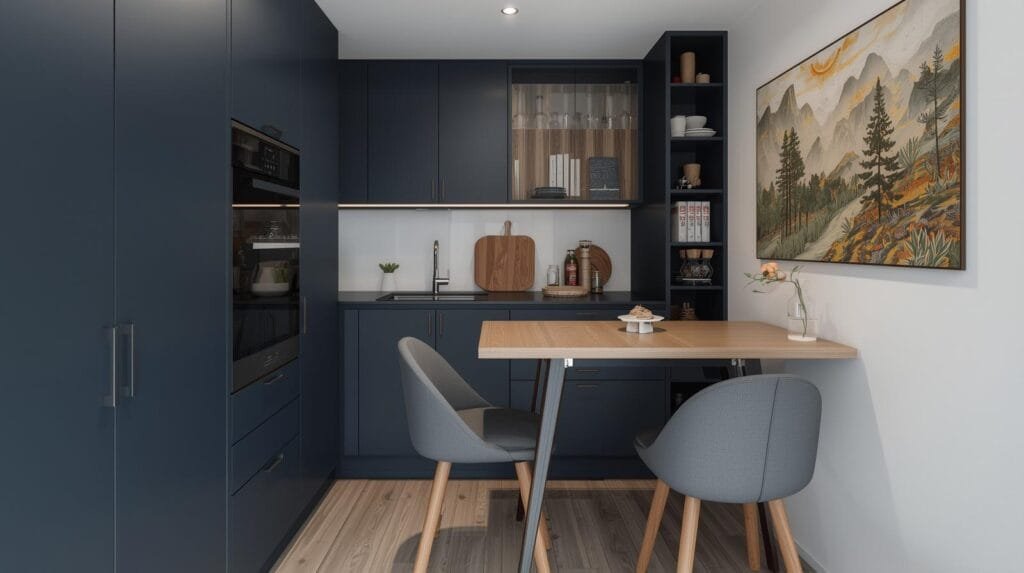
Because every inch counts in a mini kitchen, you’ll want furniture that works harder for you.
Convertible tables expand when you’re cooking and collapse for dining.
Storage ottomans tuck under counters, hiding essentials while providing seating.
These dual-purpose pieces maximize functionality without sacrificing style, letting you create a kitchen that adapts to your lifestyle.
Organize With Drawer Dividers and Containers

Once you’ve maximized your furniture, it’s time to organize what’s inside.
Invest in drawer organization systems with dividers tailored to your needs. Container variety matters—combine shallow bins, vertical organizers, and stackable boxes.
Invest in drawer dividers and varied containers—shallow bins, vertical organizers, and stackable boxes—to transform clutter into functional zones.
This strategic approach transforms cluttered drawers into functional zones.
You’ll join others who’ve mastered compact kitchens by creating accessible, streamlined storage that makes cooking easier and spaces feel intentionally designed.
Add Strategic Lighting

Lighting’s the game-changer that transforms a cramped kitchen into a functional, visually expansive space.
You’ll want to layer ambient lighting overhead for general illumination, then add task lighting under cabinets and above countertops where you prep meals.
This strategic combination eliminates shadows, highlights your design choices, and makes your compact kitchen feel larger and more welcoming.
Utilize Corner Solutions

Corners in a mini kitchen often become wasted real estate, yet they’re prime opportunities to maximize storage and functionality.
You’ll transform these awkward spaces with corner cabinets featuring pull-out shelves and lazy Susans.
This space efficiency strategy lets you access items easily without reaching blindly.
You’re creating a cohesive community of smart storage solutions that make your compact kitchen feel intentionally designed and genuinely livable.
Keep Countertops Clear
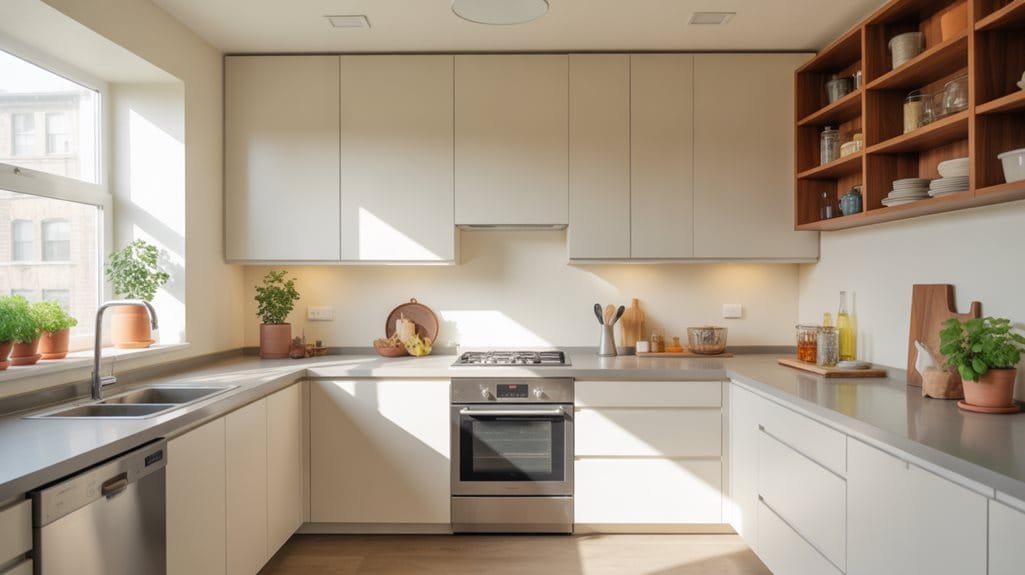
While smart storage solutions hide items away, what you display on your countertops shapes how spacious your mini kitchen actually feels.
Adopt decluttering strategies by keeping only essential appliances visible. Choose sleek countertop materials that reflect light, amplifying openness.
You’ll create breathing room that makes your compact kitchen feel intentionally designed rather than cramped, inviting others to gather comfortably.
Incorporate a Breakfast Nook or Bar Seating
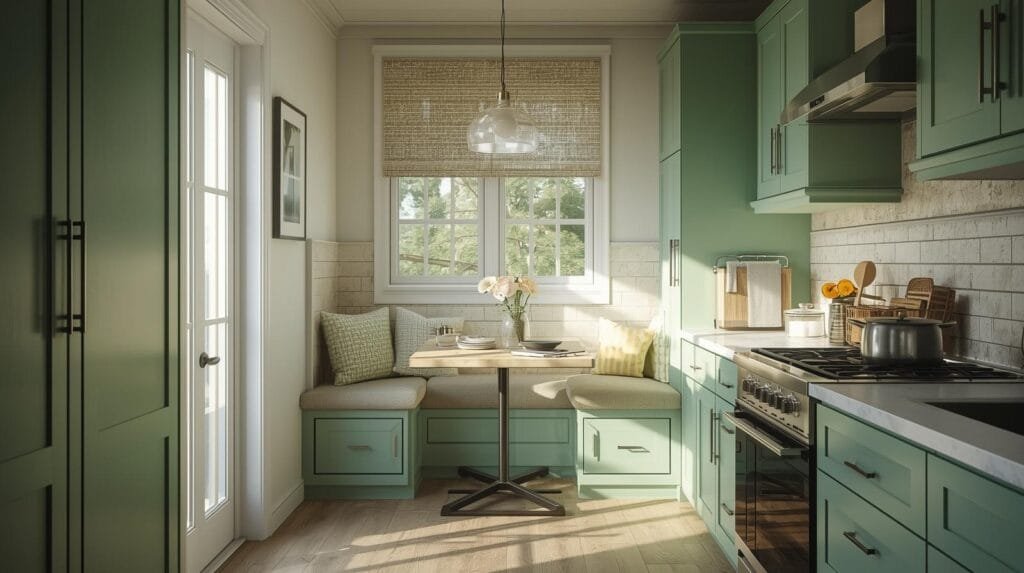
Transforming underutilized spaces into functional dining areas doesn’t require sacrificing your kitchen’s footprint.
You’ll create an inviting gathering spot by installing a compact breakfast nook or bar counter along your wall.
Pair sleek bar stools with minimalist breakfast designs to maximize seating without cluttering your layout.
This approach lets you share meals together while keeping your kitchen efficient and connected—the perfect sanctuary for your family.
Frequently Asked Questions
What’s the Best Flooring Material for Small Kitchens?
You’ll find vinyl tiles and hardwood alternatives offer your best options for small kitchens. They’re durable, visually expand your space, and fit seamlessly with modern design trends that fellow homeowners love.
How Can I Improve Ventilation in a Tiny Kitchen Space?
You’ll maximize airflow by installing a powerful exhaust fan above your cooktop. Strategically position windows to capture natural light and cross-ventilation. These smart choices keep your compact kitchen feeling fresh and inviting—just like home.
Which Paint Colors Make Small Kitchens Feel Larger?
You’ll expand your tiny kitchen visually by choosing light color palettes—whites, soft creams, and pale grays. Pair these with reflective surfaces like glossy cabinets and metallic accents. They’ll bounce light throughout your space, making it feel airier and more welcoming.
Should I Remove Walls to Expand My Mini Kitchen?
You shouldn’t rush into wall removal without evaluating your kitchen layout first. Consider whether you’re structurally removing load-bearing walls or simply reconfiguring your space. Strategic wall removal can transform your mini kitchen into an open, inviting community hub that’ll make you feel right at home.
What’s the Ideal Counter Depth for Compact Kitchens?
You’ll want to stick with 24 inches—it’s your sweet spot for compact kitchens. This depth maximizes storage solutions while keeping counter height at standard 36 inches, giving you that professional, uncluttered look you’re after.

As an amazon associate I earn from qualifying purchases.

